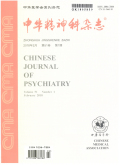摘要:患者男,37岁,已婚,大专.18年前逐渐出现眠差,2007年10月眠差加重、伴紧张焦虑、猜疑,疑家中有鬼怪,常晕倒,2007年10月10日就诊新华医院门诊;查头颅CT、心电图均无异常,诊断为重度神经衰弱;经氟西汀20 mg/d、氯硝西泮2 mg/d治疗1个月,症状加重.2007年11月14日首次就诊我院门诊.患者表现焦虑,头晕、心慌、浑身不适,诊断焦虑症,予舍曲林50 mg/d,佐匹克隆7.5 mg/d治疗4个月,症状持续存在.2008年3月25日因1周前出现疑妻害己,殴打妻子,并坚信右颞部肌肉已死亡10余年,再次就诊我院,并收住院治疗;入院后生命体征正常,神经系统未见异常体征,血常规、血生化、心电图检查均未见异常;精神检查:存在被害妄想,夸大妄想,情感反应较平淡,行为紊乱,冲动打人,自知力无.根据中国精神障碍分类与诊断标准第3版( CCMD-3)精神分裂症诊断标准,诊断为精神分裂症,予奥氮平40 mg/d、奋乃静6 mg/d治疗;2008年4月9日因出现尿潴留,换用氯丙嗪350 mg/d、奎硫平400 mg/d及无抽搐电休克治疗,1个月后症状减轻自动出院.2008年10月10日因拒药,言行紊乱,猜疑,眠差,再次入住本院.入院后拒食,尿潴留,余未见异常体征.接触被动,数问一答,存在被害妄想,夸大妄想,疑人偷物,情感反应淡漠,意志减退,行动呆滞,自知力无;诊断为精神分裂症,予奥氮平40 mg/d、舒必利600 mg/d治疗1个月,妄想减轻,能主动进食和小便,但每日晚遗尿.2008年11月24日出现模仿言语及行为,痴笑,表情幼稚,近事记忆、计算、常识及判断能力均下降,2008年12月9日中国修订韦氏成人智力量表(WAIS-RC)检查为100分,头颅核磁共振检查未见明显异常.因患者认知功能进一步下降,2009年2月26日WAIS-RC检查为72分.梅毒检查显示:快速血浆反应素环状卡片试验阳性(1:2),明胶颗粒凝集试验1:80阳性(+++),脑脊液检查华氏反应阳性,淋巴细胞数增加,蛋白定性阳性,胶金曲线成典型麻痹型.根据国际疾病分类第10版(ICD-10)麻痹性痴呆的诊断标准,更改诊断为麻痹性痴呆.

